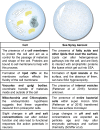Sea Spray Aerosol: Where Marine Biology Meets Atmospheric Chemistry
- PMID: 30648145
- PMCID: PMC6311946
- DOI: 10.1021/acscentsci.8b00674
Sea Spray Aerosol: Where Marine Biology Meets Atmospheric Chemistry
Abstract
Atmospheric aerosols have long been known to alter climate by scattering incoming solar radiation and acting as seeds for cloud formation. These processes have vast implications for controlling the chemistry of our environment and the Earth's climate. Sea spray aerosol (SSA) is emitted over nearly three-quarters of our planet, yet precisely how SSA impacts Earth's radiation budget remains highly uncertain. Over the past several decades, studies have shown that SSA particles are far more complex than just sea salt. Ocean biological and physical processes produce individual SSA particles containing a diverse array of biological species including proteins, enzymes, bacteria, and viruses and a diverse array of organic compounds including fatty acids and sugars. Thus, a new frontier of research is emerging at the nexus of chemistry, biology, and atmospheric science. In this Outlook article, we discuss how current and future aerosol chemistry research demands a tight coupling between experimental (observational and laboratory studies) and computational (simulation-based) methods. This integration of approaches will enable the systematic interrogation of the complexity within individual SSA particles at a level that will enable prediction of the physicochemical properties of real-world SSA, ultimately illuminating the detailed mechanisms of how the constituents within individual SSA impact climate.
Conflict of interest statement
The authors declare no competing financial interest.
Figures




Similar articles
-
CAICE Studies: Insights from a Decade of Ocean-Atmosphere Experiments in the Laboratory.Acc Chem Res. 2020 Nov 17;53(11):2510-2520. doi: 10.1021/acs.accounts.0c00504. Epub 2020 Oct 22. Acc Chem Res. 2020. PMID: 33086794
-
Sea spray aerosol chemical composition: elemental and molecular mimics for laboratory studies of heterogeneous and multiphase reactions.Chem Soc Rev. 2018 Apr 3;47(7):2374-2400. doi: 10.1039/c7cs00008a. Chem Soc Rev. 2018. PMID: 29451571 Review.
-
Bringing the ocean into the laboratory to probe the chemical complexity of sea spray aerosol.Proc Natl Acad Sci U S A. 2013 May 7;110(19):7550-5. doi: 10.1073/pnas.1300262110. Epub 2013 Apr 25. Proc Natl Acad Sci U S A. 2013. PMID: 23620519 Free PMC article.
-
Ocean Aerobiology.Front Microbiol. 2021 Oct 29;12:764178. doi: 10.3389/fmicb.2021.764178. eCollection 2021. Front Microbiol. 2021. PMID: 34777320 Free PMC article. Review.
-
Molecular characteristics of sea spray aerosols during aging with the participation of marine volatile organic compounds.Sci Total Environ. 2024 Dec 1;954:176380. doi: 10.1016/j.scitotenv.2024.176380. Epub 2024 Sep 19. Sci Total Environ. 2024. PMID: 39304158
Cited by
-
Reduction and Photoreduction of NO2 in Humic Acid Films as a Source of HONO, ClNO, N2O, NO X , and Organic Nitrogen.ACS Earth Space Chem. 2022 Dec 15;6(12):3066-3077. doi: 10.1021/acsearthspacechem.2c00282. Epub 2022 Dec 1. ACS Earth Space Chem. 2022. PMID: 36561196 Free PMC article.
-
Photooxidation of Nonanoic Acid by Molecular and Complex Environmental Photosensitizers.J Phys Chem A. 2024 Nov 14;128(45):9792-9803. doi: 10.1021/acs.jpca.4c05608. Epub 2024 Nov 5. J Phys Chem A. 2024. PMID: 39498797 Free PMC article.
-
Investigating the High-Temperature Water/MgCl2 Interface through Ambient Pressure Soft X-ray Absorption Spectroscopy.ACS Appl Mater Interfaces. 2023 May 31;15(21):26166-26174. doi: 10.1021/acsami.3c02985. Epub 2023 May 18. ACS Appl Mater Interfaces. 2023. PMID: 37199730 Free PMC article.
-
Why do some metal ions spontaneously form nanoparticles in water microdroplets? Disentangling the contributions of the air-water interface and bulk redox chemistry.Chem Sci. 2024 Nov 18;16(3):1115-1125. doi: 10.1039/d4sc03217a. eCollection 2025 Jan 15. Chem Sci. 2024. PMID: 39620073 Free PMC article.
-
Faster but Not Sweeter: A Model of Escherichia coli Re-level Lipopolysaccharide for Martini 3 and a Martini 2 Version with Accelerated Kinetics.J Chem Theory Comput. 2024 Aug 13;20(15):6890-6903. doi: 10.1021/acs.jctc.4c00374. Epub 2024 Jul 15. J Chem Theory Comput. 2024. PMID: 39008538 Free PMC article.
References
-
- Holmes N. S. A Review of Particle Formation Events and Growth in the Atmosphere in the Various Environments and Discussion of Mechanistic Implications. Atmos. Environ. 2007, 41, 2183–2201. 10.1016/j.atmosenv.2006.10.058. - DOI
-
- Satheesh S. K.; Krishna Moorthy K. Radiative Effects of Natural Aerosols: A Review. Atmos. Environ. 2005, 39, 2089–2110. 10.1016/j.atmosenv.2004.12.029. - DOI
-
- Turpin B. J.; Saxena P.; Andrews E. Measuring and Simulating Particulate Organics in the Atmosphere: Problems and Prospects. Atmos. Environ. 2000, 34, 2983–3013. 10.1016/S1352-2310(99)00501-4. - DOI
-
- Andreae M. O.; Rosenfeld D. Aerosol-Cloud-Precipitation Interactions. Part 1. The Nature and Sources of Cloud-Active Aerosols. Earth-Sci. Rev. 2008, 89, 13–41. 10.1016/j.earscirev.2008.03.001. - DOI
-
- Meyer L.; Rajendra K. P. IPCC, 2014: Climate Change 2014: Synthesis Report. Contribution of Working Groups I, II and III to the Fifth Assessment Report of the Intergovernmental Panel on Climate Change; PCC: Geneva, Switzerland; pp 1–151.
Publication types
LinkOut - more resources
Full Text Sources
Research Materials
Miscellaneous

